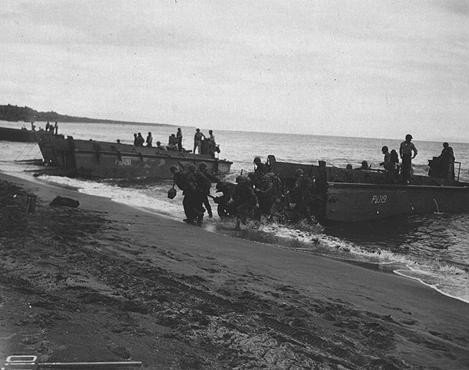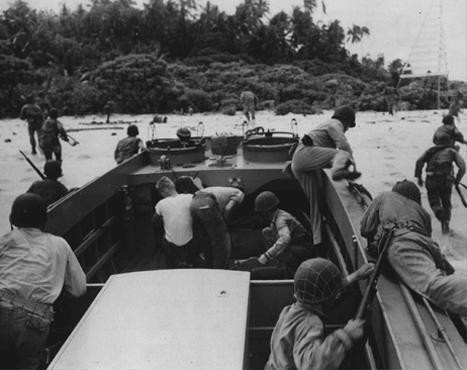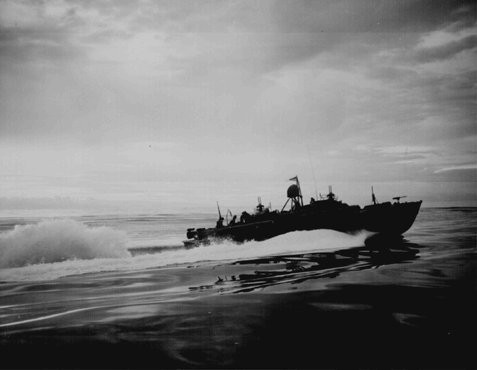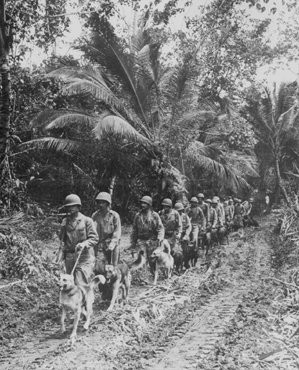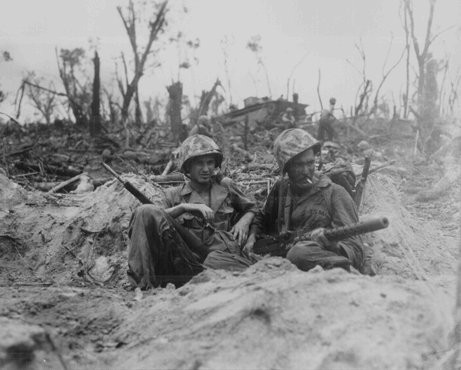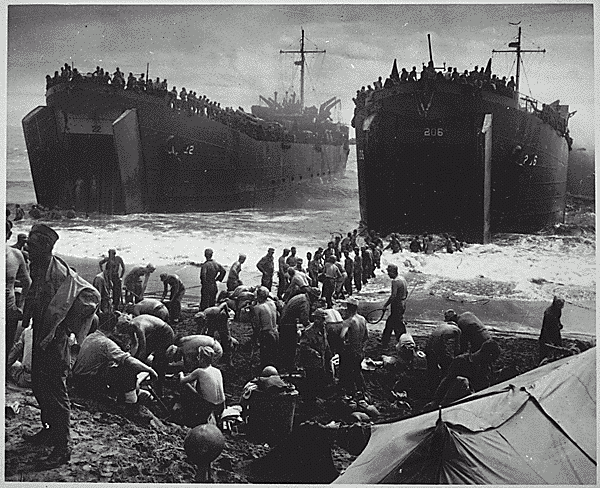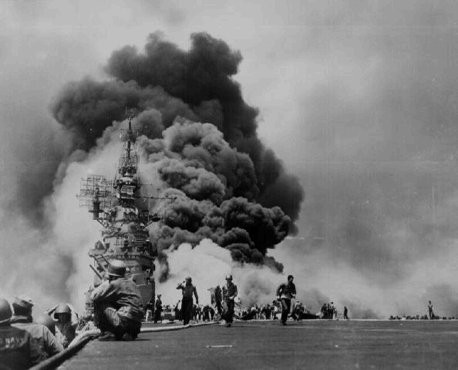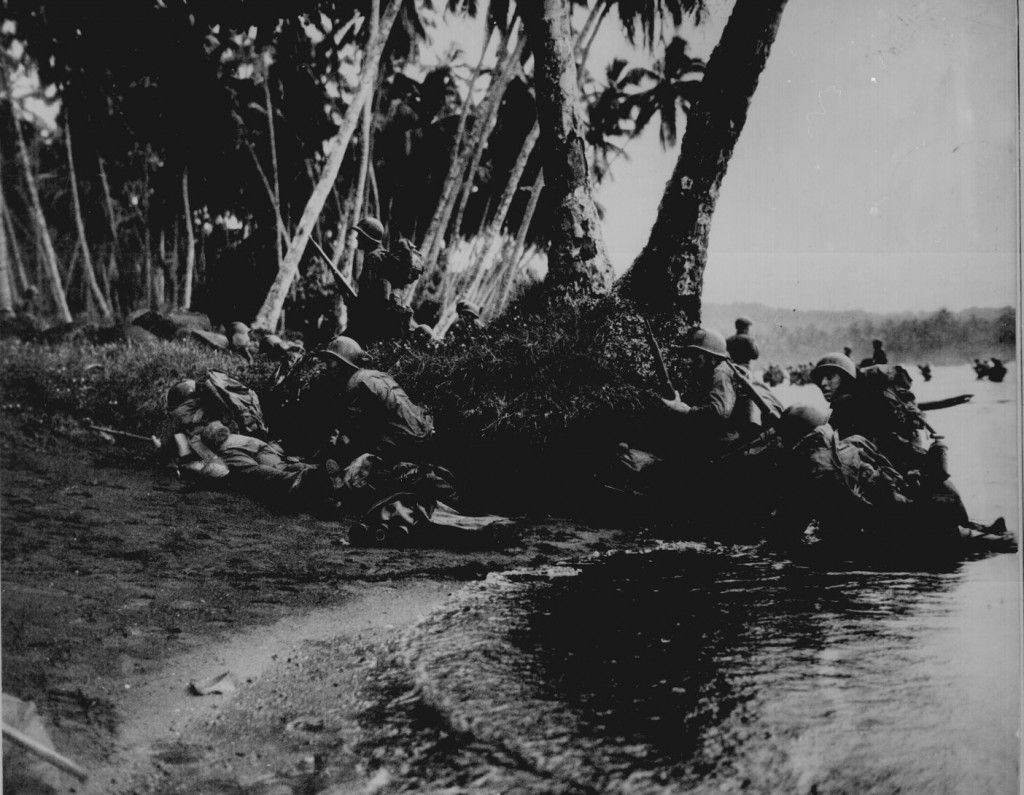
World War II in the Pacific
World War II in the Pacific started after Japan’s surprise attack on Pearl Harbor in December 1941. This attack drew the United States into war after many years of an isolationist foreign policy. The United States joined Great Britain and other allied nations in multiple theaters of war across the globe. They fought against the Axis powers, led by Imperial Japan, Nazi Germany, and Fascist Italy. The events of World War II, including those in the Pacific, ultimately reshaped world politics.
Key Facts
-
1
In the 1930s, Imperial Japan wanted to secure its dominance in the Pacific. It forged an alliance with Nazi Germany and Fascist Italy in 1937. This alliance would last through the end of World War II in 1945.
-
2
Japanese aircraft attacked Pearl Harbor on December 7, 1941, drawing the United States into both the Pacific and European theaters of war. US military efforts eventually helped change the course of World War II, leading to the defeat of Nazi Germany and the other Axis powers.
-
3
World War II in the Pacific was marked by heavy casualties and significant destruction, including the first use of an atomic bomb in warfare.
World War II (1939–1945) was fought primarily in two regions: the Pacific theater and the European theater. The Pacific theater included Japan, China, and several islands across the Pacific Ocean and Asia. The European theater included the European continent, as well as areas in North Africa and the Soviet Union.
Although these regions were geographically distinct, the wars in these two theaters became inextricably linked, especially after Japan attacked the United States at Pearl Harbor in December 1941. Pearl Harbor drew an isolationist United States into war. It prompted Japan and Germany to recommit to the alliance forged in the years before World War II.
World War II in the Pacific was a brutal conflict. It led to significant casualties and destruction for both the Allied and Axis powers. The United States’ use of atomic bombs in Hiroshima and Nagasaki in August 1945 ended World War II, with devastating consequences for Japan’s civilian population.
Japanese Territorial Expansion: The 1930s
By the early 1930s, Imperial Japan had been in an economic depression for many years. Japan lacked access to raw materials for production within its own borders. It hoped to gain economic security by taking control of territories on the Pacific Rim. These territories could give Japan access to oil, rubber, and other commodities. The United States, United Kingdom, Soviet Union, and the Republic of China were significant obstacles to Japan’s expansion.
Imperial Japan set its sights on territory in the Republic of China. At this time, China was a nationalist and anti-communist state under the leadership of Chiang Kai-shek (1887–1975). Japan invaded the Chinese province of Manchuria in 1931. The following year, Japan turned this conquered territory, Manchukuo (1932–1945), into a puppet state. Although Manchukuo was allegedly an independent state, it was controlled by Japan. Japan hoped to use the territory as its base for further expansion in the Pacific.
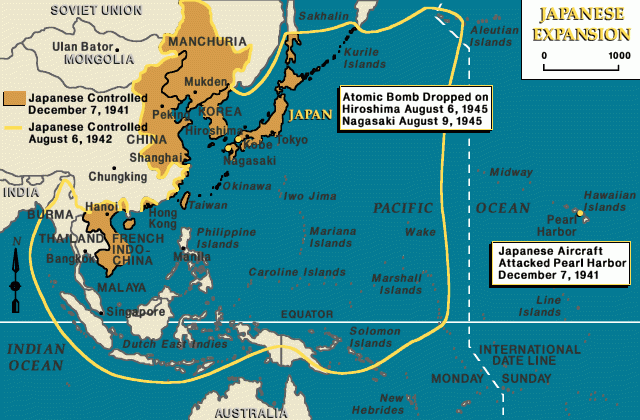
The League of Nations responded to Japan’s invasion of Manchuria by conducting an investigation. The League was an international organization founded in the aftermath of World War I (1914–1918). It aimed to protect nations’ territorial sovereignty and prevent future wars. US leaders had lobbied for the creation of the League of Nations, but the United States never joined the League. The League concluded that Japan had forcibly seized and occupied a large section of Chinese territory without a declaration of war. It condemned Japan and urged Japan’s leaders to remove their troops from the occupied lands.
In response, Japan withdrew from the League of Nations in March 1933. In October 1933, under the leadership of Chancellor Adolf Hitler, Germany also left the League of Nations. These withdrawals marked a breakdown of post-World War I efforts to promote peace through international cooperation.
Japan at War with China
Japan expanded its empire further after invading Manchuria, gaining control of multiple territories that had belonged to China. Tensions between Japan and China continued to rise during this period, leading to full-fledged war.
The Second Sino-Japanese War began in July 1937, when Japan entered the Chinese capital, Nanjing. As Japan gained a foothold there, it committed brutal war atrocities. The most well known was the Nanjing Massacre (or Rape of Nanjing), which began in December. During the massacre, entire villages were destroyed; tens of thousands of women were raped and tortured; and the death toll reached into the hundreds of thousands. Japan’s attack on Nanjing lasted from December 1937 through February 1938. The violence destroyed China’s capital city. Japan installed a puppet government that lasted until World War II ended in 1945.
Japan’s Alliance with Germany and Italy
As its conflict with China intensified, Japan aligned itself with both Nazi Germany and Fascist Italy. In November 1936, Japan and Germany signed the Anti-Comintern Pact, creating an alliance against the Soviet Union. Germany’s Chancellor Adolf Hitler approved of the alliance with Japan in part because he saw communism as a common enemy of both Germany and Japan. This pact helped Hitler position Nazi Germany as the leader in a fight against global communism, which Hitler falsely claimed was controlled by Jews. Italy joined the Anti-Comintern Pact in 1937.
As the war between China and Japan entered its third year, the threat of war in Europe loomed. On September 1, 1939, Germany invaded Poland. Great Britain and France soon declared war against Germany. The United States, however, remained isolated and neutral.
On September 27, 1940, just over one year after the war in Europe began, Japan signed the Tripartite Pact with Germany and Italy. In the pact, Japan recognized “the leadership of Germany and Italy in the establishment of a new order in Europe.” In return, Germany and Italy recognized Japan’s right to establish a new order “in greater East Asia.” This pact formalized the alliance between the three countries known as the Axis powers. Five other countries (Bulgaria, Croatia, Hungary, Romania, and Slovakia) eventually signed the Tripartite Pact.
The Japanese military expanded rapidly during this period. Its army more than doubled in size between 1937 and 1941. By 1941, the Japanese navy surpassed the combined power of both the British and American fleets in the Pacific.
The United States Responds
Japanese territorial aggression sparked widespread condemnation in the United States. President Franklin D. Roosevelt feared that Japanese expansion would continue beyond China, leading to attacks on Hong Kong, southeast Asia, and the Philippines, a US territory at the time.
Although the League of Nations condemned Japan's actions in China, diplomatic efforts failed to stop the fighting. President Roosevelt considered a joint Anglo-American naval blockade of Japan in December 1937, after Japanese aircraft attacked and sank several American and British vessels, including the patrol boat USS Panay. However, American isolationist sentiment was strong during the 1930s. President Roosevelt was reluctant to make it seem like he wanted the United States to enter conflicts abroad.
The United States sought to curb Japanese aggression and force Japan to withdraw from Manchuria and China. In 1940, the United States restricted exports to Japan. In 1941, the United States imposed economic sanctions on Japan. Japan was faced with severe shortages of oil and other natural resources. Driven by these shortages and the ambition to expand its empire, Japan decided to attack US and British territories in the Pacific. United States territories at this time included American Samoa, Guam, Hawaii, the Philippines, and Wake Island. British territories included Burma (now also known as Myanmar), Hong Kong, Malaya (now Malaysia), and Singapore.
Imperial Japan Attacks Pearl Harbor and the United States Enters World War II

Imperial Japan launched a surprise attack on the United States Pacific Fleet at Pearl Harbor, Hawaii, on December 7, 1941. The attack severely damaged the American fleet and caused heavy casualties.
The shocking assault on Pearl Harbor marked a major turning point in World War II. On December 8, 1941, one day after the attack, the United States declared war on Japan. On December 11, citing provisions in the 1940 Tripartite Pact, Germany declared war on the United States. The United States was now drawn into the war in the Pacific and European theaters.
After the attack on Pearl Harbor, Japan won a series of military victories. In December 1941, Guam, Wake Island, and Hong Kong fell to the Japanese. This was followed in the first half of 1942 by the Philippines, Burma, the Dutch East Indies (Indonesia), Malaya, and Singapore. Japanese troops also invaded neutral Thailand. Japan pressured Thailand's leaders to declare war on the United States and Great Britain. It was not until mid-1942 that Australian and New Zealander forces in New Guinea and British forces in India were able to halt the Japanese advance.
The Battle of Midway: The Turning Point in the Pacific
The turning point in the Pacific war came following the American naval victory in the Battle of Midway (June 4–7, 1942). Until the summer of 1942, Japan had been steadily advancing in the Pacific and pushing closer to the west coast of the United States. Before the battle, however, US intelligence had broken Japanese naval codes, allowing US forces to prepare for the attack.
Japan’s material losses and casualties in the Battle of Midway were much heavier than US losses. Some 3,000 Japanese sailors and airmen were killed in the battle, compared to more than 350 US sailors, Marines, and airmen. The United States’ victory in the Battle of Midway changed the course of the war in the Pacific.
In August 1942, US forces attacked the Japanese in the Solomon Islands. This eventually led to Japanese forces withdrawing from the island of Guadalcanal in February 1943. Allied forces slowly gained naval and air supremacy in the Pacific. They moved from island to island, often sustaining significant casualties. The Japanese, however, successfully defended their positions on the Chinese mainland until 1945.
In October 1944, US forces began retaking the Philippines from Japanese troops. That same year, the US Army Air Forces launched a strategic bombing campaign against Japan. British forces recaptured Burma.
In early 1945, the United States invaded the strategically important islands of Iwo Jima (February) and Okinawa (April). During the invasions, American forces suffered heavy casualties and faced Japanese kamikaze (suicidal) air attacks. Nevertheless, they conquered Okinawa on June 22, 1945.
Six weeks earlier, on May 8, 1945, Allied forces, including millions of American soldiers, defeated Nazi Germany and its Axis collaborators. Their victory ended World War II in Europe and the Holocaust.
Atomic Bomb and the End of the War in the Pacific
On August 6, 1945, the US Army Air Forces dropped an atomic bomb on the Japanese city of Hiroshima. The initial explosion killed tens of thousands of people. Many more died later from radiation exposure. Three days later, the United States dropped a second atomic bomb on the Japanese city of Nagasaki. Estimates vary, but between 110,000 and 210,000 civilians died as a result of the two blasts.
On August 8, the Soviet Union declared war on Japan and invaded Japanese-occupied Manchuria.
Japan agreed to surrender on August 14, 1945. Afterwards, US forces occupied the country. Japan formally surrendered to the United States, Great Britain, and the Soviet Union on September 2, 1945.
Death Tolls During the War in the Pacific
The death toll during World War II in the Pacific was extensive, affecting soldiers and civilians alike.
Japan’s deaths during World War II totaled as many as three million. Roughly two million of these deaths were soldiers. As many as 20 million Chinese people were killed during the war. Of these deaths, between three and four million were combatants. More than 250,000 Americans were wounded in the Pacific theater. More than 100,000 US service members died while fighting against Imperial Japan.
Key Dates and Events During World War II in the Pacific Theater
September 1931: Japan invades the Chinese province of Manchuria.
March 1933: Japan withdraws from the League of Nations.
October 1933: Germany withdraws from the League of Nations.
November 1936: Japan and Germany sign the Anti-Comintern Pact, creating an alliance against the Soviet Union.
July 1937: The Second Sino-Japanese War begins. Japan enters the Chinese capital, Nanjing.
November 1937: Italy joins the Anti-Comintern Pact.
December 1937: Japan’s attack in China’s capital city, Nanjing, begins. The attack continues through February 1938.
December 12, 1937: Japanese aircraft attack and sink several American and British vessels, including the patrol boat USS Panay.
September 1, 1939: Germany invades Poland.
September 3, 1939: France and Great Britain declare war on Germany. US President Franklin D. Roosevelt says that the United States will “remain a neutral nation.”
September 27, 1940: Japan signs the Tripartite Pact with Germany and Italy.
1940–1941: The United States starts restricting exports to Japan and eventually imposes economic sanctions.
December 7, 1941: Imperial Japan launches a surprise attack on the United States Pacific Fleet at Pearl Harbor, Hawaii. The Japanese also strike multiple other US and British territories in the Pacific.
December 8, 1941: The United States declares war on Japan.
December 11, 1941: Citing provisions in the 1940 Tripartite Pact, Germany declares war on the United States.
December 1941: Guam, Wake Island, and Hong Kong fall to the Japanese.
January–May 1942: Malaya, Singapore, the Dutch East Indies (Indonesia), the Philippines, and Burma fall to the Japanese.
June 4–7, 1942: The US naval victory in the Battle of Midway changes the course of the war in the Pacific.
August 1942: US forces attack the Japanese in the Solomon Islands.
February 1943: Japanese forces withdraw from the island of Guadalcanal.
October 1944: US forces began retaking the Philippines from Japanese troops.
Early 1945: American forces invade the islands of Iwo Jima (February) and Okinawa (April).
May 8, 1945: Victory in Europe Day. Nazi Germany surrenders unconditionally.
June 22, 1945: American forces conquer Okinawa.
August 6, 1945: The US Army Air Forces drop an atomic bomb on the Japanese city of Hiroshima.
August 8, 1945: The Soviet Union declares war on Japan and invades Japanese-occupied Manchuria.
August 9, 1945: The United States drops an atomic bomb on the Japanese city of Nagasaki.
August 14, 1945: Japan agrees to surrender, and US forces occupy the country.
September 2, 1945: Japan formally surrenders to the United States, Great Britain, and the Soviet Union. World War II in the Pacific ends.
Footnotes
-
Footnote reference1.
In October 1949, four years after the end of World War II, the People’s Republic of China (PRC) was established. This ended a civil war between the Chinese Communist Party (CCP) and the Nationalist Party, or Kuomintang (KMT), which had been in power since 1927.
-
Footnote reference2.
A puppet government is one that appears to be operating independently but in fact is controlled by the government of another country.
Critical Thinking Questions
Investigate the context of war and mass murder in Europe at the time the United States entered the war.
Did the course of the war in the Pacific affect the possibility of rescue of the endangered Jews by the Allies and other nations?
How and why did the United States government relocate Japanese-Americans from the Pacific coast in 1942?


